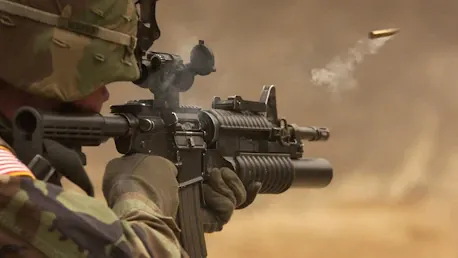The recent accreditation of Inzpire’s Compact Agile Simulation Equipment for Joint Terminal Attack Controllers (CASE JTAC) marks a noteworthy advancement in mixed-reality training technology. This system has gained approval for Type 1, 2, and 3 controls, becoming the first accredited mixed-reality JTAC simulator in the United Kingdom. Certified by the UK Ministry of Defence (MoD) and endorsed by an international Memorandum of Agreement led by the US, CASE JTAC has established its significance within NATO competency and currency training for JTACs. In this roundup article, perspectives from various experts shed light on the transformative capabilities of CASE JTAC, its impact on military training, and its future potential.
High-Fidelity Virtual Environments
Immersive Training Experience
James Clarkson, Inzpire’s lead engineer, underscores the importance of CASE JTAC’s realistic synthetic battlespace that merges real-world peripherals with high-fidelity virtual environments. He explains that the 360-degree immersive experience provided by this mobile and rugged system ensures effective on-location training for JTACs and close air support (CAS) practitioners. Clarkson notes that the ability to conduct training in familiar environments and realistic settings significantly enhances operational readiness and performance.
Lt. Col. Mark Hastings, a JTAC instructor with 20 years of experience, emphasizes the value of realistic training environments in preparing trainees for real-world scenarios. Hastings believes that the CASE JTAC’s all-encompassing synthetic battlespace allows trainees to experience the complexity and unpredictability of actual missions, thereby better preparing them for the challenges they will face in the field. This level of immersive training, according to Hastings, fosters faster learning and increased confidence among trainees.
Real-World Mission Rehearsal
Senior JTAC trainer, Captain Sarah Ward, highlights the system’s capability to pre-rehearse real-world missions within a low-risk simulated environment. Ward points out that CASE JTAC includes tools for after-action reviews, data-driven feedback, and proficiency tracking, which are key components in refining training and ensuring effectiveness. She believes that incorporating these tools into the training regime leads to improved decision-making skills and operational proficiency.
Lt. Col. Robert Jenkins from the US Air Force adds that the system’s robust feedback mechanism enables trainees to learn from their mistakes in a controlled setting. Jenkins appreciates how proficiency tracking ensures that each trainee reaches the required standards before participating in live exercises. CASE JTAC’s comprehensive feedback process, Jenkins suggests, contributes to building resilient and well-prepared JTACs.
Cutting-Edge Mixed-Reality Technology
Engaging and Interactive Learning
Alex Turner, a mixed-reality technology specialist, praises CASE JTAC for leveraging advanced technology to create engaging and interactive learning experiences. Turner explains that the system allows trainees to interact with both real and replica equipment in lifelike scenarios, which enhances muscle memory and overall preparedness. The unique 360° environment, Turner says, offers diverse visual perspectives, including over-the-shoulder and behind-the-user views, which expand the range of Type 1 control attack profiles that can be effectively trained.
Training specialist Dr. Emily Spencer notes that this integration of mixed-reality technology helps in bridging the gap between theory and practical application. Spencer stresses that by engaging in realistic and interactive scenarios, trainees can assimilate complex concepts more efficiently and apply them in actual operations. The immersive nature of CASE JTAC’s training experience, according to Spencer, results in higher retention rates and better mission outcomes.
Enhanced Simulation Capabilities
In collaboration with partners Varjo, Bohemia, and SIMcentric, Inzpire has pushed the boundaries of mixed-reality fidelity. Varjo’s XR-4 Focal Edition headsets, known for their unparalleled visual clarity, are integrated into the system along with Bohemia’s virtual battlespace software and SIMcentric’s tools. These components elevate CASE JTAC’s simulation capabilities, providing unmatched realism for close air support and ground fire operations.
Andrew Miller, a virtual reality (VR) expert, notes that the combination of Varjo’s headsets and Bohemia’s software results in an exceptionally immersive and realistic training experience. Miller points out that such high-fidelity simulations are crucial for effective training, as they closely resemble the conditions of real-world operations. This fidelity, adds Miller, builds confidence and competence among JTACs.
Comprehensive Training Solutions
Customized Training Programs
CASE JTAC is available for purchase as a standalone product or as part of a comprehensive service that includes customized training from Inzpire’s accredited instructors. Training coordinator Rachel Black highlights that the system supports both individual and team-based training sessions for JTACs, forward air controllers, joint forward observers, fire support teams, and command staff. This flexibility, Black asserts, allows for tailored training programs that meet the specific needs of various units.
Command Sergeant Major Steven Rogers sees great value in the availability of customized training programs. He explains that the ability to design training sessions specific to unit requirements enables a more focused and effective learning experience. This level of customization, Rogers believes, ensures that trainees are better prepared to meet their operational objectives.
Scalability and Multi-Role Training
CASE JTAC’s scalable networking capabilities facilitate the creation of complex multi-role training scenarios and dynamic vignettes. This feature challenges trainees’ decision-making skills and prepares them for a range of potential real-world operational conditions. Training manager Claire Harper emphasizes that these scalable capabilities enable the simulation of diverse mission profiles, which is essential for comprehensive training.
Defense analyst Michael Adams notes that the scalability of CASE JTAC allows for the integration of various elements and forces, resulting in a more holistic training approach. Adams highlights that such multi-role training scenarios are invaluable in ensuring that trainees can handle the complexities and nuances of real-world operations. The dynamic vignettes, according to Adams, keep training sessions engaging and relevant to current operational realities.
Future Enhancements and Demonstrations
NATO Exercise Success
CASE JTAC has demonstrated its potential through successful participation in NATO exercises where innovations like the vari-focus system in pass-through cameras have enhanced visual system accuracy. James Clarkson, Inzpire’s lead engineer, points out that these advancements have been essential in creating a seamless integration between real-world and synthetic environments, significantly boosting the realism of the training experience.
NATO exercise coordinator Lt. Col. Andrea Russo acknowledges the positive impact of CASE JTAC’s participation in these exercises. Russo remarks on how the system’s vari-focus camera technology has provided trainees with clearer and more accurate visual cues, leading to better decision-making during simulated missions. Such enhancements, Russo believes, contribute to the overall success and credibility of CASE JTAC as a premier training solution.
Ongoing Development
Inzpire continues to enhance CASE JTAC by incorporating new British Army equipment, ensuring the system remains at the forefront of air-land integration training. This commitment to ongoing development, according to Inzpire’s product manager Laura Green, guarantees that the system will stay relevant to future military training needs. Green notes that continuous improvements are essential to maintaining the high standards expected by modern defense forces.
Innovation strategist Patrick Mason emphasizes the importance of continuous development in keeping training systems like CASE JTAC relevant and effective. Mason points out that the evolving nature of military operations necessitates regular updates and enhancements to training solutions. By integrating new technologies and equipment, Mason suggests, CASE JTAC will remain a vital component of JTAC and CAS training programs.
As CASE JTAC continues to evolve, it offers a promising future for mixed-reality military training. Experts agree that its advanced simulation capabilities, customizable training programs, and commitment to ongoing development position it as a key player in preparing JTACs for the complexities of modern warfare.









